What to do in Matera?
MATERA, “The Stone Town”. Matera is an important city, known throughout the world. Its great peculiarity is due to its caves, called “Sassi”. Its roots go back to the beginnings of man and go further. In the current ravine where it is, through historical events and major events, (the last and most crucial, the choice of the Lucanian city as the European Capital of Culture in 2019), after having been declared a UNESCO World Heritage Site in 1993. So, what to do in Matera, the European capital of culture of 2019? Here at Your Travel to Italy with Ana Patricia you make the trip of your dreams!!! ALSO: see our “Accommodation in Italy – Tips for your holidays!”
Source: Pixabay and Flick
Prev 1 of 0 NextIntroduction
Matera is one of the oldest cities in the world. Its territory bears testimony of human fossils from the Paleolithic era. The city had many rulers during its history, being under the control of the Romans, Lombards, Saracens and Byzantines. In the 11th century, the Normans arrived, and remained there for a long time, bringing peace and stability; later they were harmed by the Aragonese and, finally, Matera gained the position of independence and was of great importance in the early 800s, becoming the capital of Basilicata. Car itinerary in the Basilicata region?
There are several theories about the etymology of the name Matera, according to Colaianni, the city was called by the Greeks “Mataia ole”, a term derived from “mataio olos” (all empty) with evident reference to the structures of the ravines. According to other sources, the term was derived from “mata” (pile of stones) or from the initials of Met (point) and Hera (clea), two neighborhoods that welcomed refugees from two Magno-Greek centers after their destruction.
1) What to do in Matera? THE SASSI
The Sassi are the oldest part of the city of Matera. The unique architecture of the Matera caves narrates the man’s ability to adapt perfectly to the environment and the natural context, using skillfully simple resources such as constant temperature of the excavated places, white lime to build houses on the surface and the use of the slope to control the water outlet and monitor meteorological phenomena.
The sassi are private constructions, erected inside the rock of the Ravine of Matera, the deep gorge, which divides the territory of the city into two large natural amphitheaters: the Sasso Caveoso and the Sasso Barisano.
Sasso Caveoso neighborhood
In the Sasso Caveoso neighborhood, dwellings that are almost completely carved out of the rock prevail and, most impressive, have remained intact since the past. The Sasso Barisano neighborhood, which underwent a complete reconstruction, houses several restored structures and inns, as well as tourist attractions (an example is the reconstruction of the miniature Sassi and the museum of civilization).
Built around Civita, it is an entire city carved out of the limestone rock, locally called “tufo”, an articulated housing system, stuck on the slopes of a deep valley, with unique and surprising natural characteristics. Do you know what we are talking about? Gravina. The overlapping of the various phases of urban transformation over the rigid Murge structure, the refined dialogue between rocks and architecture, canyons and campaniles, have created this urban scenario of incompatible beauty over the centuries.
2) What to do in Matera? ATTRACTIONS
What to see in Matera? When you arrive at Matera, there is always this impasse: what to choose to see first, so that the city is visited and seen in its entirety, discovered step by step and loved by what it offers to visitors. I quote a phrase from Carlo Levi, in which he clarifies: “Anyone who sees Matera cannot help but be awe-struck, so expressive and touching is its sorrowful beauty.”
The Rupestrian Churches of Matera
Today, the sassi of Matera have been reconsidered as a tourist spot and open to the public and, finally, have become a real luxury. The sassi are one of the peculiarities that make Matera so famous in the world and, therefore, are the first things to visit when you arrive in the city. However, Matera is also much more than that.
Rupestrian churches are particularly interesting, representing a significant number of stages in human history. These places bear witness to man’s evolutionary transition from the prehistoric era to Christianity. In reality, Rupestrian churches are located in places where in the past they were of particular importance and, most likely, they were already places of worship in the rupestrian civilizations that preceded those Christian ones. The most visited and most interesting are:
Santa Maria di Idris – San Giovanni in Monterrone (St Mary of Idris and St John in Monterrone)
The church of Santa Maria di Idris is located within the rocky spur of Monterrone, in Sasso Caveoso, close to the church of San Pietro Caveoso (St Peter Caveoso) and the homonymous square. The position is stupendous and offers a unique panorama of the city and the Gravina.
Santa Lucia alle Malve (“St Lucia at Malve”)
The rupestrian church of Santa Lucia alle Malve is located in the vicinity of the previous church, Santa Maria di Idris, in the district of Malve. It is the first female monastic settlement of the Benedictine order, existing since the 8th century, and the most important in the history of Matera. Inside the church there are some of the most beautiful and important mural paintings in the Materani territory.
San Pietro Barisano (St Peter Barisano)
It is in Sasso Barisano that is the largest rock church in the city of Matera, originally known as Pietro in Veteribus. Through archaeological investigations, it was possible to identify the first underground rock building, which dates back to the 12th-13th centuries.
Matera Churches
Matera is also known for the large number of churches present at the site; we point out some of the most relevant ones. Starting with the Cathedral of Matera, a rare example of romantic pugliese style, which was built in the 12th century on the highest spur between Sasso Barisano and Sasso Cavernoso (where a monastery of Benedictine friars previously appeared).
A curiosity of this cathedral is the high belfry, with more than fifty-two meters. Inside it is possible to notice the beautiful Byzantine fresco ‘Madonna della Bruna’. Another example of a romantic church is the sanctuary of San Giovanni Battista. Also of great importance for the territory and the state in which it is found is the church of San Pietro Caveoso, which dates back to 1218. To this church, a baroque belfry was added in the 17th century, expanding its eccentricity. Also, the church of San Francesco d’Assisi (St Francis Assisi) is very interesting, another example of Baroque architecture.
Map 01 with the attractions in Matera
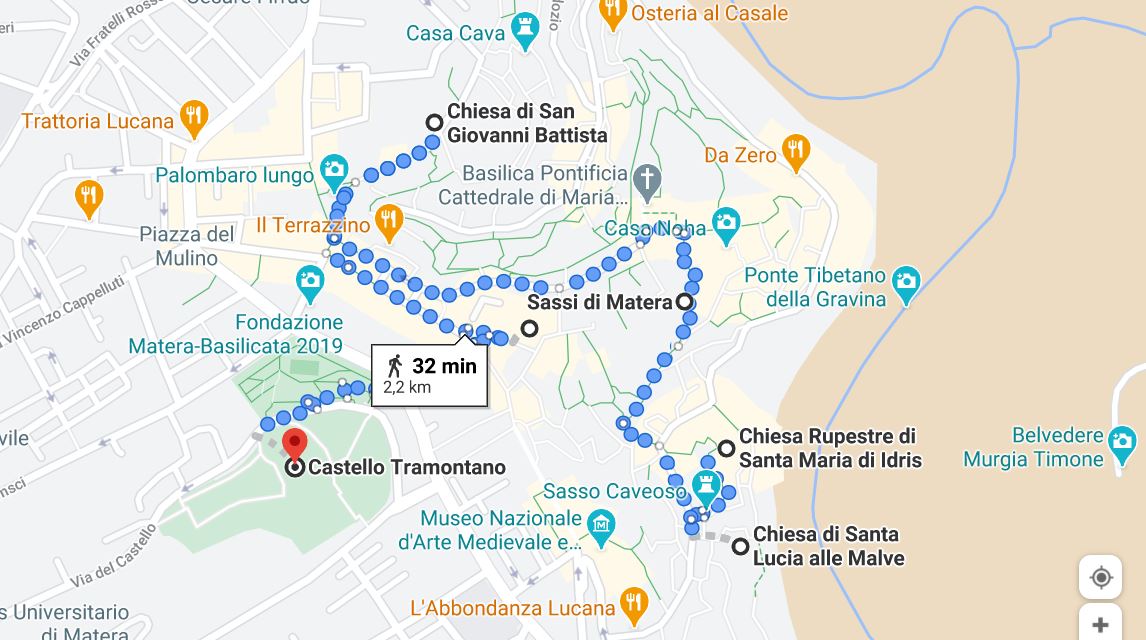
Religious Architecture
Regarding religious architecture, these are undoubtedly worth visiting: the Aragonese-style Tramontato Castle, the Lanfranchi Palace, home of the National Museum of Modern and Medieval Art in Basilicata, and the Annunziata Palace, which dominates the central square of Matera. In addition, another attraction of notable importance is the Vittorio Veneto Square, with its ferdinandea fountain.
Map 02 with the attractions in Matera
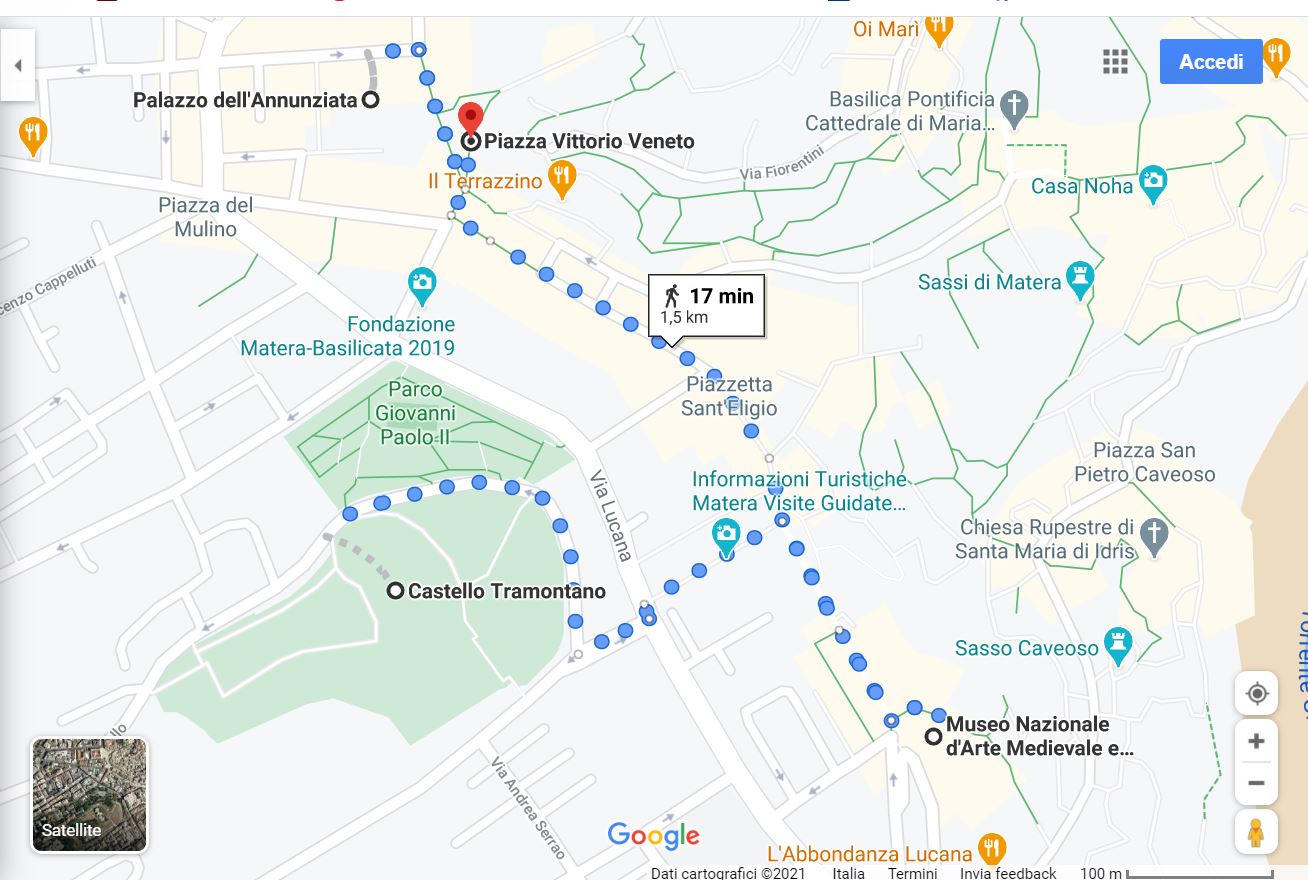
3) What to do in Matera? FILMS SHOT IN MATERA
The various films shot within the city walls also play a decisive role for Matera, who, on the one hand, managed to represent the evolution of tourism and on the other hand denounced the degradation in which the city found itself after the Second World War. In reality, it was Carlo Levi himself who, with his film “Christ stopped in Eboli”, shook public opinion and even paved the way for the city’s revival, which is now designated as “European Capital of Culture 2019” (and before it was considered a cause for shame for Italy; without a doubt a great transformation).
Movie-tours
This and other films gave Matera the primacy of Lucan cinema capital (fame that reverberated in a notable way for tourism, favoring the birth of the so-called “movie-tours”, through which one can discover and relive the most suggestive places chosen by the great Italian and foreign filmmakers). Matera houses all these spaces, scenarios and perspectives that on the big screens revealed all their grandeur, enchanting the eyes and touching the hearts.
Let’s remember some of the various films
Starting in 1949 with Carlo Lizzani who, welcoming all contradictions, produced a documentary aimed at discovering this town more closely, about which Carlo Levi speaks so much. In the ’60s, the sassi were abandoned. The strong degrading sense serves well to portray this southern setback that is represented in the films: “Gli anni Ruggenti” (“Roaring Years”), “Il demonio” (“The Demon”), “I Basilischi” (“The Basiliks”), “Qui comincia l’avventura” (“Here the Adventure Begins”), “Cristo si è fermato ad Eboli” (“Christ stopped in Eboli) and “Terra bruciata” (“Scorched Earth”).
Director Pasolini also shot the film “The Gospel According to St Matthew”, em 1964, a film in which the blocks of the sassi acquire almost a metaphysical sense, immobile, timeless and outside the historical period.
Mel Gibson’s Passion of the Christ
In 1985 Matera’s heart of stone was transformed into Jerusalem with King David, which was repeated in 2002 with the film “The Passion of the Christ”, by Mel Gibson. Some streets in these colossal films have become fundamental, such as the Via Muro, which is panoramic, scenic and spectacular, served as a location for Via Crucis in Mel Gibson’s film, “The Passion of the Christ”.
Old Town
Walking along the perimeter of the old neighborhood of Civita, you can find the oldest village of the inhabitants of the city. At the heart of medieval urbanization, this rocky fort separates the two sassi and, at its top, are the palaces of the nobility and the Cathedral. The incredible steps of the Via Muro gave life to the most threatening scenes in Gibson’s work, where the local people, who were hired in large numbers during the making of the film, appear alongside the professional actors.
Like Mel Gibson, Hardwicke also chooses Via Muro as a cinematographic set, but to represent a popular market. In her film “Jesus: The Birth Story”, she sets up a meeting and barter point for the villagers and prepares a set design with a gate, exotic palm trees and stalls for the sale of goods.
Via Lombardi and Via Fiorentini, in Sasso Barisano
In order to film the scene of Via Crucis and the escape of the apostle Simon during Jesus’ journey to Calvary, in “The Gospel According to Matthew”, Pasolini preferred Via Lombardi and Via Fiorentini, in Sasso Barisano. To the northwest of the Gravina waterfront, Sasso Barisano is the richest district in portals and sculpted friezes, which are hidden in the underground heart. Where before it was a crucial scenario in the life of this civilization, today there are hotels and restaurants, in addition to the various tourist attractions – such as the reconstruction of miniature sassi and the museum of civilization.
More
Before being the city we all know today, also loved by its peaceful and famous caves, Matera was considered one of the most backward towns in southern Italy, so much so that the Sassi have become synonymous with backwardness and underdevelopment. After the Second World War, after the commotion triggered by the film “Christ Stopped in Eboli”, national public opinion was always more interested in the living conditions of the inhabitants of the Sassi, taking Palmiro Togliatti first and then Alcide de Gasperi to visit it. , respectively in the years 1948 and 1952. The latter was the one who established, on May 17th, 1952, the law No. 619, with which he proposed the restoration of the Sassi and the construction of new neighborhoods for the city.
New Neighborhoods
Starting with the most unhealthy areas, the residents of the Sassi gradually evacuated the city and, simultaneously, built new neighborhoods (such as the districts of Serra Venerdì, Platani, Borgo La Martella, Spine Bianche, Villalongo, Lanera, Agna, Piccianello and Venusio ). Thus, the inhabitants who came from Sasso Caveoso and Sasso Barisano, who were expelled from their old houses, were received and, from that moment, most of them became the property of the State.
Due to the expropriation of the houses, the residents paid a negligible rental fee to inhabit the new neighborhoods. The city of stone (the whole of Matera, not just the sassos) is a matter of art, poverty that becomes wealth and beauty, a nuisance that becomes an opportunity. This is the message that, if they know how to value their architectural heritage well, it will spread throughout Europe.
How to get to Matera?
If you want to visit the city that hosted culture in 2019, one of the first questions to ask is: how to get to Matera? Before looking at how to get to the Lucan capital with each means at our disposal, let us focus on the fact that the city does not have a direct public railroad, although it is possible to access it by train.
1) How to get to Matera? BY AIRPLANE
To arrive in Matera by air, you can consider the Bari Palese airport, which is the closest, just 60 km away (and has better access to the city, thanks to the shuttle and bus services). It is also good to remember that Bari airport offers connection from the central station, connecting Matera via the Appulo Lucane railway. Many national and international flights depart from Bari airport.
Also read our Special Posts on Airports in Italy:
- HOW TO GO FROM THE ROME AIRPORT TO THE CENTER OF ROME?
- HOW TO GO FROM THE MALPENSA AIRPORT TO THE CENTER OF MILANO?
- HOW TO GO FROM VENICE AIRPORT TO VENICE CENTER
2) How to get to Matera? BY TRAIN
As I said earlier, the city of Matera does not have a public rail network, so to access the city by train it is necessary to use the Appulo Lucane railways (narrow gauge railways), which connect the city of the Sassi to Bari on a regular basis.
Did you know that Trenitalia is the main Italian company dedicated to the management of railway transport? Also find out “What is the difference between trains in Italy?”. Would you like to save? So buy your ticket online in advance and save a lot, read the Post “How to buy a train ticket in Italy?“.
3) How to get to Matera? BY BUS
Compared to other means, there are several bus options (considering that the city is not so well connected to the rest of Italy, due to the lack of public train stations). Buses fulfill this need well; this is why it is possible to arrive in Matera from Milan, Ancona, Bologna, Chinciano, Fiuggi, Naples, Novara, Parma, Reggio Emilia, Sassuolo and Urbino (and so many other foreign cities). Marino Company offers these lines, while Marozzie Liscio offers connections through Rome, Florence, Pisa and the Siena.
4) How to get to Matera? BY CAR
To access Matera from the Tyrrhenian coast, it is necessary to take the Salerno-Reggio Calabria road. From there, you should follow the signs towards Potenza and then Metaponto. After leaving the main road, you will take state road 407, following the signs towards Ferrandina Scalo and, finally, Matera. However, those who wish to access Matera via the Adriatic coast have to take the Bologna-Taranto road, which must be traveled to the Bari Nord border. From there, you must continue with the signs for Matera on the SS96, then SS99.
Read our latest posts on traveling by car in Italy:
Traveling by car in Italy
How about if I give you a rental car option? Are you ready for it? If you are renting a car be sure to read our posts in the section Driving in Italy on the blog Your Travel to Italy. In addition to car itinerary tips, we have everything about signage, tolls, roads and many more tips.
Don’t know where to rent the car?
We have a partner that can help you: Rent Cars! Have you ever thought about renting a car in Italy, without leaving your home? Click on the banner below to learn more! Search, compare and choose!
Watch this video and learn: Discovering Calabria with Ana Patricia: tour in Cosenza
Subscribe to our channel and receive more videos with information and tips about Italy. Don’t forget to leave that Like;)
TRAVEL TO ROME!
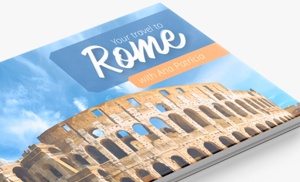
“Your Travel to Rome” is the quintessential e-book for your travel to one of the finest tourist destinations on the planet!
LEARN MORE
Conclusion
What to do in Matera? Anyone who sees Matera cannot help but be awe-struck, so expressive and touching is its sorrowful beauty. And if you feel insecure or have no time, and need help to organize your trip, do not hesitate to look for me! I will love to help you make your dream trip to Italy. And how can I do that? Continue reading this post until the end and you will understand how can we make your life and journey easier.
Did my post help you? If yes, make sure to leave your comment below, but if you still have questions, just leave them as a comment below and I will reply, O.K.?
An Extra Help for your Trip
The best content from Your Travel to Italy!
Learn more about our tours in Italy right now!
- What to visit in Italy in 10 days?
- The ten must-see places in Tuscany?
- The best tips to save on your trip to Italy?
- What are the 10 most visited cities in southern Italy?
- Airports in Italy? How to get to your hotel? (Venice, Milan, Rome, Florence)
- What to do in 1/2/3/4 days in the main Italian cities?
- The best tips on food in Italy (wines, typical food, enogastronomy tours)
- How to get from Fiumicino Airport to Rome downtown?
- Your Travel to Italy: 10 tips for traveling through Italy!
Best regards from Italy

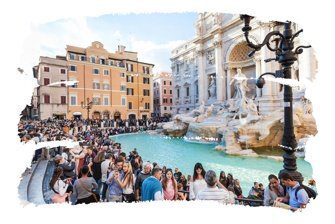
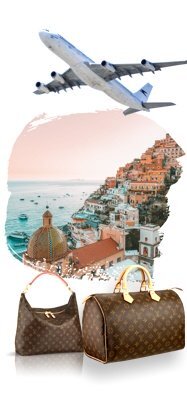


 Save money!
Save money!